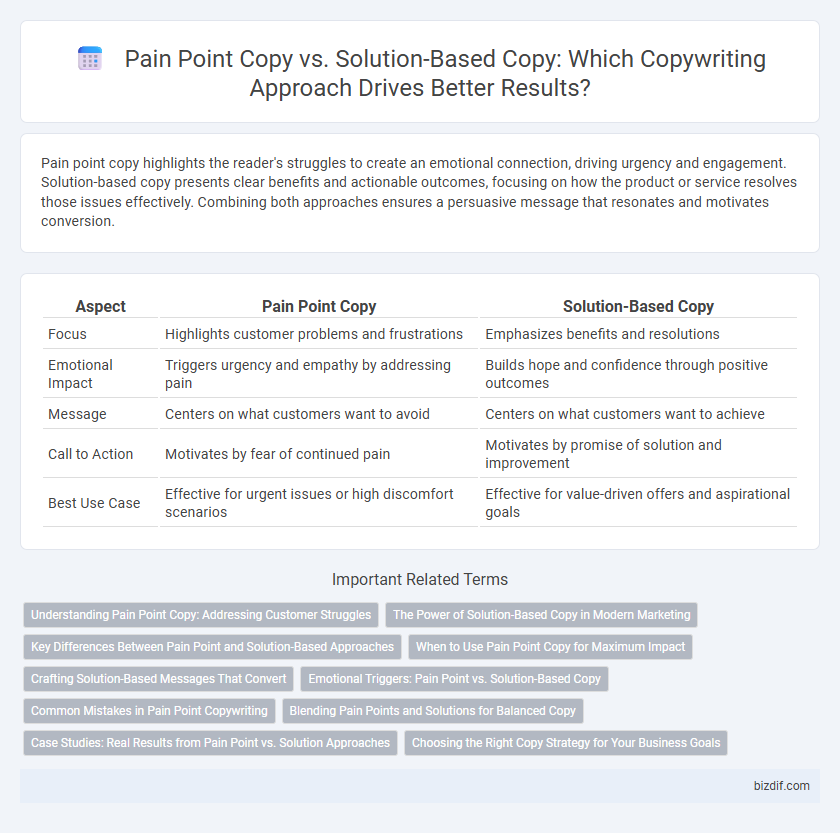Pain point copy highlights the reader's struggles to create an emotional connection, driving urgency and engagement. Solution-based copy presents clear benefits and actionable outcomes, focusing on how the product or service resolves those issues effectively. Combining both approaches ensures a persuasive message that resonates and motivates conversion.
Table of Comparison
| Aspect | Pain Point Copy | Solution-Based Copy |
|---|---|---|
| Focus | Highlights customer problems and frustrations | Emphasizes benefits and resolutions |
| Emotional Impact | Triggers urgency and empathy by addressing pain | Builds hope and confidence through positive outcomes |
| Message | Centers on what customers want to avoid | Centers on what customers want to achieve |
| Call to Action | Motivates by fear of continued pain | Motivates by promise of solution and improvement |
| Best Use Case | Effective for urgent issues or high discomfort scenarios | Effective for value-driven offers and aspirational goals |
Understanding Pain Point Copy: Addressing Customer Struggles
Pain Point Copy targets specific customer challenges by highlighting common frustrations and obstacles to create emotional resonance. This approach increases engagement by validating the audience's experiences and positioning the brand as empathetic and trustworthy. Understanding pain points enables copywriters to craft messages that directly address customer needs, driving higher conversion rates.
The Power of Solution-Based Copy in Modern Marketing
Solution-based copy focuses on addressing customer needs by highlighting benefits and outcomes, which increases engagement and conversion rates. By emphasizing how products solve specific problems, this approach builds trust and motivates action more effectively than pain point copy. Modern marketing leverages solution-based copy to create compelling messages that resonate with target audiences and drive sustained business growth.
Key Differences Between Pain Point and Solution-Based Approaches
Pain point copy highlights the audience's specific problems and emotional triggers to create urgency, making readers feel understood and prompting immediate engagement. Solution-based copy, on the other hand, emphasizes clear benefits and outcomes by showcasing how the product or service resolves those problems effectively. The key difference lies in pain point copy focusing on the problem's impact, while solution-based copy stresses the resolution and value provided.
When to Use Pain Point Copy for Maximum Impact
Pain point copy is highly effective when targeting audiences already aware of their challenges, as it directly addresses their frustrations and creates emotional resonance. This strategy works best in the early stages of the buyer's journey, where recognition of the problem motivates engagement. Leveraging detailed customer pain points can significantly increase conversion rates by presenting the product or service as the specific remedy needed.
Crafting Solution-Based Messages That Convert
Solution-based copywriting focuses on highlighting the benefits and outcomes that directly address customer needs, driving higher engagement and conversion rates. This approach emphasizes clear, actionable value propositions tailored to solve specific challenges, making the message more relatable and persuasive. Crafting these messages requires deep audience insight and a strong emphasis on how the product or service transforms the customer's experience.
Emotional Triggers: Pain Point vs. Solution-Based Copy
Pain point copy taps directly into the audience's frustrations and fears, eliciting an emotional response by highlighting specific problems that need urgent attention. Solution-based copy appeals to the desire for relief and positive outcomes, using optimistic language to inspire confidence and hope. Both strategies leverage emotional triggers, but pain point copy drives urgency through discomfort while solution-based copy fosters trust through promise.
Common Mistakes in Pain Point Copywriting
Common mistakes in pain point copywriting include overemphasizing customer problems without offering clear solutions, which can leave readers feeling discouraged or overwhelmed. Writers often fail to deeply research the target audience's genuine pain points, resulting in generic or irrelevant messaging that lacks emotional resonance. Ignoring the balance between highlighting pain and presenting benefits reduces engagement and conversion rates in marketing campaigns.
Blending Pain Points and Solutions for Balanced Copy
Blending pain point copy with solution-based copy creates a balanced message that resonates emotionally while offering clear value to the reader. Highlighting specific customer struggles establishes empathy, while immediately presenting targeted solutions builds trust and motivates action. This integrated approach enhances engagement and conversion by addressing both the problem and its resolution seamlessly.
Case Studies: Real Results from Pain Point vs. Solution Approaches
Case studies reveal that pain point copy effectively drives urgency by highlighting customer frustrations, resulting in a 30% higher engagement rate compared to neutral messaging. Solution-based copy demonstrates a 25% increase in conversion by clearly showcasing benefits and outcomes tailored to target audiences' needs. Combining both approaches in A/B testing yields insights that optimize messaging strategies for maximum ROI in copywriting campaigns.
Choosing the Right Copy Strategy for Your Business Goals
Pain point copy targets specific customer struggles to evoke emotional responses, driving urgency and engagement. Solution-based copy highlights the benefits and outcomes of your product or service, appealing to customers seeking clear value and results. Choosing the right copy strategy depends on your business goals--use pain point copy for awareness and connection, and solution-based copy to emphasize effectiveness and conversions.
Pain Point Copy vs Solution-Based Copy Infographic

 bizdif.com
bizdif.com